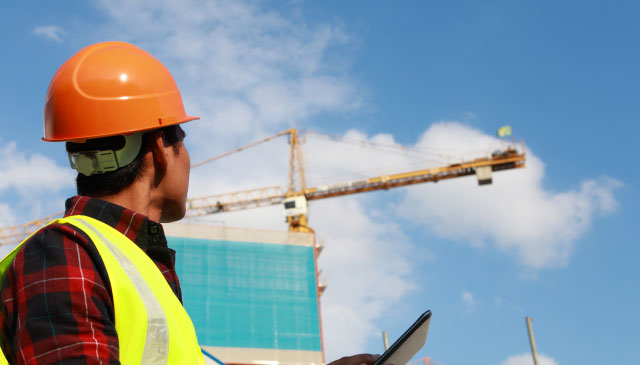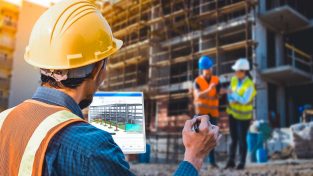BK: Welcome back to HxGN RADIO. My name is Brian. Thank you for joining us.
Construction technology is often developed for use in the office. Robust and complex, these software solutions can manage costs, timelines, budgets and more. However, once a project begins the construction process, the software often is too complex to allow for jobsite adoption. Hexagon Solution HxGN SMART Build has introduced advanced work packaging to the building industry to help promote jobsite technology adoption.
Today I’m here with Mark Goldman, vice president product management, AEC and BIM. Mark, thanks for joining me.
MG: Hey, my pleasure to be here. Thanks for inviting me.
BK: I appreciate it. We’re excited. We’re hanging out in person. I love doing this stuff. We get to actually hang out together.
MG: Well, there’s nothing like getting together one on one.
BK: Yeah.
MG: We do enough WebExs and try to work remotely.
BK: Oh, I know.
MG: Talking and chatting in person is always the best.
BK: Exactly. When you got people from all over the world, most of the time you’re on Skype or you’re on a phone call or something. This makes it so much more fun.
All right, tell us a little bit why technology adopted at the jobsite can be a challenge.
MG: There’s a number of reasons. I see it falling into three areas. There’s the logistics of technology. Is your equipment really ready to go onto the jobsite? Is it ruggedised or is it, perhaps, purpose-built? Purpose-built technology that knows the condition it’s going to be in. Muddy, wet environment. It might get handled a little more abruptly in a construction environment than you might handle things at your house. There’s logistics of Wi-Fi and getting connected, which I see going further and further away in being issues. Both, because it’s as common as electricity now, except in the most remote job sites.
Secondly, technology is like the Edge platform. Edge Frontier, Edge Client, that Hexagon delivers is actually bringing connectivity to the jobsite through the IOT initiatives that we’re doing. Actually creating outside of Wi-Fi. Some of those logistic issues, I think, are goingo to just go away day by day.
There’s the mindset of technology on a jobsite just doesn’t belong there. “That’s not how we do things here.” The perception that costs of technology will outweigh the benefits. A history of the tools simply being too difficult to use. Purpose-built for someone sitting at a desk doesn’t meant that the tool is going to adapt well when you put it on an iPad.
BK: Yeah, yeah.
MG: Those three reasons around mindset. I’d say just complexity in general. The challenge of learning something new. Handling new devices. I think there’s a number of reasons why technology at the jobsite has been a struggle historically. I think it’s going away.
BK: What happens when the technology’s too complex?
MG: It simply doesn’t get adopted. Many of the benefits related to cost savings, schedule compression, improved safety, quality, don’t get realised.
BK: Yeah.
MG: I don’t believe the use of technology in any environment needs to be complex these days, given the clean slates that we have and the tools that we use to design software. The expectation of design being built into the tools that we use. Whether it’s a hammer or an iPad, the element of design being such an important factor in what we do today.
The need or the expectation that tools will be too complex is something that I don’t think we should be considering, especially if myself as a product owner, someone who’s working on new software, and someone who’s influencing some of the hardware that is used in construction. If I can make my voice loud enough and develop software that’s as easy to use for anyone, then the complexity part of construction goes away. All those benefits can be realised.
BK: I appreciate that. Cause you do see it. It still happens. You’ve got the complexity out there, and somebody says, “Well, I need to adopt this new technology. You know what? Forget it. I don’t have time for this. I’m too busy. I’ve got other things to worry about. I’ll just do it the old way.” Of course, that doesn’t necessarily work in their favor. Having a simple solution is exactly what we should expecting.
MG: Exactly. The old way certainly does work.
BK: Yeah.
MG: You’ve building, building, buildings or laying roads for 10, 20, 50 years using the old way, but new companies are forming and management is turning over in the construction industry. We’re seeing a real change in the age profile of the construction industry. Newer generations are bringing in both an expectation of new tools and visibility into new ways of working that are changing the construction industry. I think for the better.
BK: Excellent. That’s great to hear. What do people on the jobsite actually need, then, when they’re working in the field?
MG: It depends on what they’re trying to do. Out on the jobsite, you’re simply trying to track progress on work that has been assigned to you. It might be as simple as your handheld device, which we’re enabling with SMART Build. If you’re looking to capture the progress of construction on a regular basis and be able to compare that to the design and the engineering that should be occurring, that did occur and is illustrating what construction should occur at a given time. If you want to do these progress scans, then you’re talking about reality capture devices.
Other equipment are robotic total stations from our Leica Geosystems division. If you want to be more productive in placing layout points and capturing the location of construction where it occurred vs. where it was intended to occur, using a robotic total station brings tens to hundred times productivity as compared to manual processes.
These technologies might have a perception of complexity. We’re working to make them as easy to use as possible. Designing that both into the hardware and software, so that your original question, “What happens when technology is too complex?” You’re not getting these benefits of tens to hundreds of times productivity and higher quality. You’re not having the reality of a construction site captured for you to review down the road for litigation purposes. Or at real time to ensure what you expected to be happening is happening.
If you’re fearful of letting your construction team all use their handheld devices in an app to track progress, then you’re relying on daily reports. By the time they roll up to management, could be weeks behind.
BK: Yeah. Very true. Very true. Explain a little bit about work packaging.
MG: Work packaging, we’re delivering that in Hexagon SMART Build. It’s simply a description of the work steps that would be required to complete a work effort. With a planned start and an end date. A link to and references to the resources that are required to perform that task, so the materials, the labour, any special equipment. We link those resources to cost data.
BK: Mm-hmm.
MG: We visualise that in SMART Build. Essentially, it’s the task level detail of work that is aligned with the work breakdown structure that is already used in construction.
BK: Excellent. Love it! How does this address the adoption of technology, as we were talking about earlier?
MG: The adoption of technology. If you can report progress on a work package in the field, if the job site superintendent, the foreman or even the craftsman, if he can, in real time indicate what work he’s working on and what level of completion he’s working on, those work packages are connected from the field back to the progress indicators on a desktop. The benefits of that, the value of adopting that technology, is this real-time feedback between those in the field, who you’re paying to perform work, and perhaps yourself sitting in an office trying to understand progress, payments, earned value.
BK: Mm-hmm.
MG: Important indicators of whether your company is doing well. Field adoption of technology doesn’t just make a team more productive, but it provides this link between the field and the office.
BK: Absolutely. What other benefits is this going to mean?
MG: The way we’re delivering work packages, they’re viewed and managed in a schedule environment. Your work package is this combination of work effort and work task. If you can visualise that in the model, then the benefit is just a greater insight into the progress of your work.
We visualise the cost data, as well. You’re able to see the work that’s being performed where that work relates to the costs that have been spent in that area of the budget. Essentially, your earned value. You’re able to visualise earned value, not just in the traditional lines and diagrams and charts and green bar spreadsheets. Visualising that work package in the model gives a level of understanding of the project status that anyone on the team may need. Certainly construction executives, project planners, estimators, etc.
We see work packaging being part of the success of the process, power, marine, ship yard. The traditional industries that Hexagon PPM has served. As-work packages in a way that the industry stays more on budget and more on schedule than the historical methods of, perhaps, Gantt-based traditional project planning methods. We want to take that learning and apply it to the construction industry, who in some parts of the world, are using work packaging and seeing higher productivity and higher quality of construction than other areas who aren’t using work packaging.
BK: Excellent. I was going to ask about the feedback. Do you have any specific examples?
MG: Yeah. This is new to the construction industry. Hexagon SMART Build. The case studies that the traditional PPM customers have explained to us, companies who traditionally are serving as an EPC, an engineering procurement construction company, also have an AEC division. They’re very interested in the tool we’re building for the traditional construction industry built on some of the best practices that the process, power and marine space have seen. We’ll have some case studies to come, hopefully this time next year.
BK: Excellent. It looks great, sounds great. It really does solve a great problem, so appreciate that.
MG: Sure.
BK: All right. Mark, thank you so much for taking the time today. Anything else you want to share before we wrap up?
MG: I think this is an amazing time for anyone in the construction industry, either from my perspective as a technologist trying to understand the needs and turn those into solutions that can help the field and the office be more productive. I’ve been working in the intersection of construction and technology for about 25 years, and I’ve seen the booms and busts of construction and he booms and promises and busts of technology. I think we’re at one of the greatest points right now with the availability of cloud computing.
BK: Yeah.
MG: The concept of computing at the edge, IOT, big data, the adoption of building information modelling. This is an amazing time for the construction industry and an amazing time for Hexagon to be serving this industry that I love and enjoy working at.
BK: That’s great. It’s great that you love it. It’s great that it’s an exciting time. This is wonderful. Awesome! Thank you.
MG: My pleasure.
BK: I appreciate that. More information about HxGN SMART Build over at HxGNSMARTBuild.com. Mark, thanks again. Appreciate it.
MG: My pleasure.
BK: Be sure to tune in to more episodes at HxGNRADIO.com, iTunes, Soundcloud, Stitcher Radio. Thanks for joining us.

















